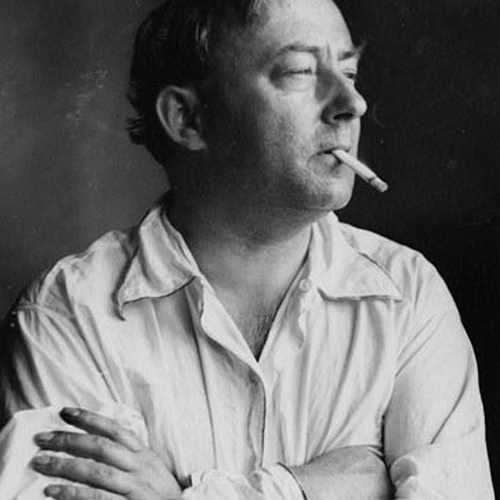Max Schwimmer
As a painter and illustrator, Max Schwimmer reveals a unique erotic sensualism, whose foremost means of expression are an explicit colourism and the subtle elegance of his drawing style. After late expressionistic beginnings, he developed his painting in the 1920s under the influence of the Fauvism of Henri Matisse and Pierre Bonnard, mediated by his teacher Hans Purrmann, into bright, joyful tonal colours. As a draughtsman, he remained devoted to the German Impressionist Max Slevogt throughout his life, even if the strong experience of Max Beckmann's painting almost turned him away after 1945 and led to metaphorical compression.

curriculum vitae
| 1895 | born in Leipzig |
| 1910-1915 | Education as a primary school teacher at the Lehrerseminar in Leipzig-Connewitz |
| 1916 | Assistant teacher and vicar in Obersaida and Marienberg |
| 1917 | Own studio in Leipzig |
| Beginning of free artistic career | |
| 1918 | Starts collaborating with the satirical magazine »Die Aktion« |
| 1919-1923 | Studies Art History and Philosophy at Leipzig University |
| Joined the anti-bourgeois cabaret scene and came into contact with Hans Reimann, Erich Weinert, Slang (Fritz Hampel), Joachim Ringelnatz and Johannes R. Becher | |
| Collaborates with the satirical magazine »Der Drache« | |
| 1922 | Marriage to the graphic artist Eva Schwimmer, born Götze (1901-1986) |
| 1923 | Birth of daughter Gabriele |
| Member of the SPD | |
| 1923/1924 | Work as a teacher in Eythra near Leipzig |
| Begins many years of freelance work as illustrator for the »Neue Leipziger Zeitung« and the »Leipziger Volkszeitung« | |
| Journey to Italy and participation in a summer course with Hans Purrmann on Ischia | |
| Moves to Berlin | |
| 1925 | Birth of daughter Francis |
| Return to Leipzig | |
| 1926 | Journey to Paris and the South of France |
| 1926-1933 | Drawing teacher at the Kunstgewerbeschule in Leipzig |
| 1933 | Defamation and confiscation of his works as »entartete Kunst« |
| Dismissed from his teaching position by the Nazi regime | |
| End of his work as an illustrator for the »Leipziger Volkszeitung« and turned focus on book illustration | |
| Separates from his wife Eva Schwimmer | |
| 1929 | Second journey to Paris and the South of France |
| 1934/1935 | Journey via Salzburg to Dalmatia and Czechoslovakia and stay in Brussels |
| 1939 | Conscription to medical service in Leipzig in Second World War |
| 1943 | Marriage to the graphic artist Ilske Schwimmer, born Naumann (1915-1969) |
| In the bombing raid on Leipzig on 4 December, the house, the library and a large part of his work are lost | |
| 1944 | Relocation to Wohlbach in Vogtland |
| 1944/1945 | Serves in the Wehrmacht as a guard at the Stalag IV B POW camp in Mühlberg/Elbe, finally escapes to Altenburg and from there to Wohlbach im Vogtland |
| 1945 | Member of KPD |
| 1946-1951 | Professor and Head of the Department of Graphic Arts at the Staatliche Akademie für Graphische Künste und Buchgewerbe Leipzig, dismissed in 1951 due to artistic and cultural-political differences with the Academy administration |
| 1951-1960 | Head of the Department of Graphic Arts at the Hochschule für Bildende Künste Dresden (HfBK) |
| 1952 | Ordinary member of the Deutschen Akademie der Künste Berlin |
| 1955 | Honoured with the Vaterländischer Verdienstorden in Silver |
| 1956 | Honoured with the Nationalpreis 2nd Class |
| 1956-1958 | Secretary of the Deutsche Akademie der Künste Berlin and Chairman of the Visual Arts Section |
| 1957 | Thyroid operation, increasing health problems |
| 1960 | died in Leipzig |
Schwimmer's illustrations are characterised by the lightness of the drawing, by the elegant play of lines that enliven the surface, sometimes tenderly and flatteringly, sometimes vigorously, sometimes in a measured stride, sometimes moodily and effervescently. The illustrations evoke the feeling of the lightest improvisation, giving the impression of dreamlike levitation.
Lothar Lang, Von Hegenbarth zu Altenbourg. Buchillustration und Künstlerbuch in der DDR, Stuttgart: Hauswedell 2000
His style is characterised by a spiritual line. A line that does not simply trace the outline of a figure for some kind of intended effect. Schwimmer's line expresses more. It never wants to give a simple report. It only begins where pure reproduction ends. His line is excitement, filled with desire for the object, trembling with rapture, with adoration, receiving its drive from love. It reveals his erotic relationship to the world.
Max Schwimmer. Liebling der Musen, Katalog zur Ausstellung, Dresden: Galerie Himmel 2017
Of all the Saxon artists in the last two centuries, Schwimmer is perhaps the most French. Rather, the lights of Delibes, Debussy and Ravel glimmer within them.
Leipzig den Hintern gezeigt, Sächsische Zeitung vom 2. Februar 2017
And please also extend my warmest thanks to Professor Schwimmer for his brilliantly light and delicate illustrations in the ›Diary‹, which I have greatly enjoyed. I have always had a particular fondness for this cheeky morality tale.
Johann Wolfgang von Goethe, Das Tagebuch. Mit farbigen Illustrationen von Max Schwimmer (Berlin: Verlag der Nation 1997), Vorwort
